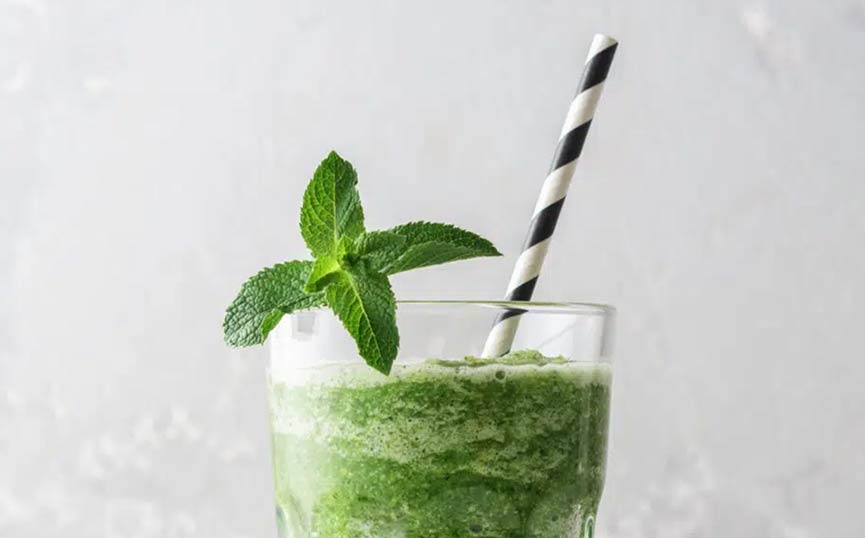Explore the effects of chlorophyll on your body!
The effects of chlorophyll are beneficial for the whole body. In this article, we'll find out what effects it has in addition to helping blood formation, and the best natural sources of chlorophyll.

For many of us, the color green is synonymous with nature, with naturalness. In contrast to the autumn, when trees and bushes shed their lifeless leaves, in spring these landscapes are green, symbolising renewal and rebirth. But why is this important to us in relation to the effect of chlorophyll? Well, this substance, which gives plants their characteristic green color, helps to absorb the light needed for photosynthesis and to transport it into plant cells to act as a motor for the synthetic processes that take place there.
Scientists also discovered over a hundred years ago that the chemical composition and molecular structure of chlorophyll is almost identical to that of haemoglobin in the blood, and that it performs very similar functions in both cases. Chlorophyll, also known as “the blood of plants”, helps human blood to form, increases oxygen levels and helps to deliver nutrients to cells. But these are just some of its many benefits. Let’s take a look at the most important things to know!
What is chlorophyll and why is it useful for us?
In short, chlorophyll is the substance that gives plants their green color. It follows that the greener it is, the more of this valuable pigment it contains. It is essential for the vitality and health of plants and is also key to their ability to perform one of their most important functions, photosynthesis.
We are not capable of photosynthesis, and we are much more complex and complicated organisms than plants. A summer shower or spring sunshine may make us feel good, but they would not in themselves be able to keep us healthy or strengthen our immune system. The vitamin D produced by sunlight is good for our bodies, but we also need to think about our circulation, digestion, the proper functioning of organs and our resistance to disease and infection.
The foods we eat and the minerals, vitamins, trace elements and compounds they contain play a crucial role in our health. Regular consumption of chlorophyll not only helps us to achieve the above, but also helps us to detoxify and alkalise our bodies and increase our energy levels. But let’s take a closer look at how chlorophyll affects our body!
The effects of chlorophyll on the human body
Since childhood, we may have been aware that eating green vegetables is very healthy, even if spinach or sorrel stew is not high on our list of favourite foods. Today, however, eating healthily has perhaps become much more important. We know, how much depends on our bodies getting the vitamins, trace elements and other compounds they need to function normally. A varied diet is important, no single food or supplement alone will solve our problems.
If we can see what chlorophyll does for us, how it protects our health, we may be encouraged to pay more attention to good nutrition. Let’s look at its main benefits!
Helps our blood health
Haemoglobin is a very important component of human blood, not only for its red color, but also for its role in oxygen uptake and transport. The main difference between the two substances is that in haemoglobin the carbon in the molecule is bound to an iron ion, whereas in chlorophyll it is bound to a magnesium ion. However, they have the same effects on our bodies, as the consumption of chlorophyll increases oxygen levels in the blood and helps our cells to get the nutrients they need. It is a great blood healer and can increase the number of red blood cells and improve their quality.
Excellent antioxidant
We’ve certainly heard a lot about antioxidants and free radicals, the former being beneficial and the latter potentially harmful to us. Antioxidants fight against free radicals: when their levels rise towards a certain level in our bodies, they can contribute to the development of serious diseases such as diabetes, cancer and heart disease. Antioxidants are produced by the body itself, but chlorophyll can help it in this important fight, reducing free radicals and cell damage.
Helps to remove heavy metals
Unfortunately, even with the greatest care, pollutants and heavy metals can still enter our bodies from food and drink, but they also be a source in tap water from an outdated plumbing system. As mentioned above, carbon in chlorophyll is bound to a magnesium ion. This, in turn, is released into an acidic environment and can bind harmful heavy metals, preventing their absorption and helping to eliminate them from the body.
Reduces hunger and improves digestion
Chlorophyll has the ability to reduce food cravings, stabilise blood sugar levels and help relieve indigestion, bloating, gas and constipation. Of course, it’s not a weight-loss miracle cure either, but it can be a useful addition to any diet, as it also speeds up the metabolism.

Helps eliminate body odour and unpleasant breath
When chlorophyll first “came into fashion” following its discovery at the beginning of the last century, many people sought it out solely because they believed it could solve all their problems. In this respect it is not a panacea either, it will not replace proper cleaning. However, by improving the health of the digestive organs and the urinary tract, it eliminates the unpleasant body odours that occur when they are not working properly, and makes the smell of urine and faeces more tolerable.
The effect of chlorophyll on the skin
Chlorophyll is an excellent anti-inflammatory and helps wounds to heal – it is even available as a regenerating spray for this purpose, significantly reducing healing time. It acts effectively against bacteria that are harmful to us, thereby reducing inflammation, swelling or redness of wounds. It also helps to regenerate damaged skin, treat foot ulcers caused by diabetes and other inflammatory skin conditions, making it a great treatment for acne and oily skin.
Other benefits of chlorophyll
It would be a lenghty task to list all the reasons why chlorophyll is worth consuming, but these are some of the benefits that are worth mentioning:
- slows down the ageing process
- cleans and strengthens the gums
- improves the functioning of the brain
- stimulates lymphatic circulation
- alkalizing effect to reduce high PH in the body
- may relieve middle ear infections or sore throats
- protects joints and muscles and its beneficial for rheumatoid arthritis
- relieves symptoms in case of radioactive contamination
How the body can get chlorophyll
As with most vitamins and minerals, it is said that the best way to get them is naturally. It is important to note that chlorophyll is a pigment, not a vitamin, but it is also beneficial to get the necessary amounts by eating green plants, vegetables and fruits. It is, however, a very sensitive compound that is not always able to be utilised during digestion. So choosing the right supplement can increase its effectiveness, whether in tablet, capsule or liquid form ensuring much better absorption.
Vegetables with chlorophyll
So the greener a plant (vegetable), the higher its chlorophyll content. However, green is not the only „healthy color”, all colors of fruits and vegetables are: orange foods are high in beta-carotene, like carrots, purple foods like aubergines and red grapes are high in anthocyanins, and red foods like tomatoes contain high levels of lycopene.
But let’s stick to chlorophyll. Dark green leafy vegetables are excellent sources of chlorophyll, here are some examples:
- asparagus
- ruccola
- broccoli
- spinach
- wheatgrass
- kale
- coriander
- parsley
Also very useful sources are various sea vegetables such as spirulina (algae), seaweed and sea grasses, but also cucumbers, green beans, brussels sprouts and green peas. Of course, it is also found in fruits, where the green color is also a starting point for the chlorophyll content. Examples include kiwi, green apples and pistachios, and even Matcha tea contains this great compound.

What are the possible side effects of chlorophyll?
Vegetables cannot be overdosed, but nothing should be consumed in unreasonable amounts or exclusively. In addition to the many benefits listed above, there may be side effects, causing discomfort in those who are sensitive to them.
It aids digestion, but in some cases may cause diarrhoea or nausea, and in worse cases vomiting. It may also give a greenish-black tinge to stools and urine – this can be scary, but only because most of the chlorophyll is excreted from the body in an uncharged form. However, it is completely harmless to consume.
We are talking about a very beneficial compound, the effects of chlorophyll are very beneficial not only for plants but also for humans. Chlorophyll is also part of a conscious diet, and is best obtained in its natural form, but we must not forget quality food supplements, which are completely safe and in many cases more effective, as they are better absorbed than natural sources. In addition, in today’s fast-paced world, they offer a practical and convenient way to stay healthy.





